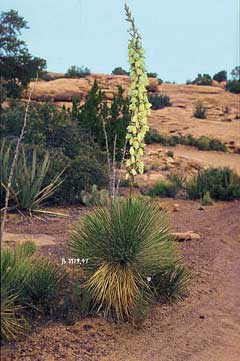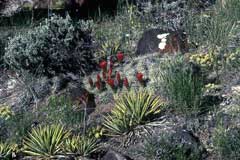 |
|
de.wikipedia.org/wiki/Benutzer:Rebou |
 |
| de.wikipedia.org/wiki/Benutzer:Rebou |
Translate this page:
Summary
Bloom Color: White. Main Bloom Time: Early summer, Early spring, Late summer, Late spring, Mid summer, Mid spring. Form: Upright or erect.
Physical Characteristics

 Yucca_angustissima is an evergreen Shrub growing to 0.4 m (1ft 4in) at a slow rate.
Yucca_angustissima is an evergreen Shrub growing to 0.4 m (1ft 4in) at a slow rate.
See above for USDA hardiness. It is hardy to UK zone 8. It is in leaf all year, in flower from June to July. The species is hermaphrodite (has both male and female organs) and is pollinated by Hand.
Suitable for: light (sandy), medium (loamy) and heavy (clay) soils, prefers well-drained soil and can grow in nutritionally poor soil. Suitable pH: mildly acid, neutral and basic (mildly alkaline) soils. It can grow in semi-shade (light woodland) or no shade. It prefers dry or moist soil and can tolerate drought. The plant can tolerates strong winds but not maritime exposure.
UK Hardiness Map
US Hardiness Map
Synonyms
Plant Habitats
Edible Uses
Fruit - the immature fruit is cooked[85]. Baked in an oven[216]. A bitter taste, the bitterness is in the skin[85]. The fruit is about 6cm long and 2.5cm wide[200]. Flowers - raw or cooked. They are delicious raw, or can be dried, crushed and used as a flavouring[85]. Flowering stem - peeled, cooked and used like asparagus. The whitish inner portion is used[85].
References More on Edible Uses
Medicinal Uses
Plants For A Future can not take any responsibility for any adverse effects from the use of plants. Always seek advice from a professional before using a plant medicinally.
None known
References More on Medicinal Uses
The Bookshop: Edible Plant Books
Our Latest books on Perennial Plants For Food Forests and Permaculture Gardens in paperback or digital formats.

Edible Tropical Plants
Food Forest Plants for Hotter Conditions: 250+ Plants For Tropical Food Forests & Permaculture Gardens.
More

Edible Temperate Plants
Plants for Your Food Forest: 500 Plants for Temperate Food Forests & Permaculture Gardens.
More

More Books
PFAF have eight books available in paperback and digital formats. Browse the shop for more information.
Shop Now
Other Uses
A fibre obtained from the leaves is used for making ropes, baskets and mats[85]. The leaves are very fibrous and can be used as paint brushes[92] or as a broom or woven to make mats etc[85]. They are also used in basketry[216]. The roots are rich in saponins and can be used as a soap substitute[85, 216].
Special Uses
References More on Other Uses
Cultivation details
Landscape Uses:Border, Massing, Specimen. Thrives in any soil but prefers a sandy loam and full exposure to the south[11]. Plants can succeed in light shade[K]. They are hardier when grown on poor sandy soils[200]. Established plants are very drought resistant, this species is also tolerant of damp weather[11]. Plants are not hardy in the colder areas of the country, they tolerate temperatures down to about -10° if in a suitable location[11, 200]. Closely allied to Y. glauca[11]. The plant has a thick prostrate rootstock[11]. In the plants native environment, its flowers can only be pollinated by a certain species of moth. This moth cannot live in Britain and, if fruit and seed is required, hand pollination is necessary. This can be quite easily and successfully done using something like a small paint brush. Individual crowns are monocarpic, dying after flowering[233]. However, the crown will usually produce a number of sideshoots before it dies and these will grow on to flower in later years[233]. Plants in this genus are notably resistant to honey fungus[200]. Members of this genus seem to be immune to the predations of rabbits[233]. Special Features:North American native, Fragrant flowers, Attractive flowers or blooms.
References Carbon Farming Information and Carbon Sequestration Information
Temperature Converter
Type a value in the Celsius field to convert the value to Fahrenheit:
Fahrenheit:
The PFAF Bookshop
Plants For A Future have a number of books available in paperback and digital form. Book titles include Edible Plants, Edible Perennials, Edible Trees,Edible Shrubs, Woodland Gardening, and Temperate Food Forest Plants. Our new book is Food Forest Plants For Hotter Conditions (Tropical and Sub-Tropical).
Shop Now
Plant Propagation
Seed - sow spring in a greenhouse. Pre-soaking the seed for 24 hours in warm water may reduce the germination time. It usually germinates within 1 - 12 months if kept at a temperature of 20°c. Prick out the seedlings into individual pots when they are large enough to handle and grow them on in the greenhouse or cold frame for at least their first two winters. Plant them out into their permanent positions in early summer and consider giving them some winter protection for at least their first winter outdoors - a simple pane of glass is usually sufficient[K]. Seed is not produced in Britain unless the flowers are hand pollinated. Root cuttings in late winter or early spring. Lift in April/May and remove small buds from base of stem and rhizomes. Dip in dry wood ashes to stop any bleeding and plant in a sandy soil in pots in a greenhouse until established[78].
Other Names
If available other names are mentioned here
Native Range
NORTHERN AMERICA: United States (New Mexico (northwest), Arizona (north), Utah (south))
Weed Potential
Right plant wrong place. We are currently updating this section.
Please note that a plant may be invasive in one area but may not in your area so it’s worth checking.
Conservation Status
IUCN Red List of Threatened Plants Status :

Growth: S = slow M = medium F = fast. Soil: L = light (sandy) M = medium H = heavy (clay). pH: A = acid N = neutral B = basic (alkaline). Shade: F = full shade S = semi-shade N = no shade. Moisture: D = dry M = Moist We = wet Wa = water.
Expert comment
Author
Engelm. ex Trevir.
Botanical References
11200270
Links / References
For a list of references used on this page please go here
Readers comment
| Add a comment |
|
If you have important information about this plant that may help other users please add a comment or link below. Only comments or links that are felt to be directly relevant to a plant will be included. If you think a comment/link or information contained on this page is inaccurate or misleading we would welcome your feedback at [email protected]. If you have questions about a plant please use the Forum on this website as we do not have the resources to answer questions ourselves.
* Please note: the comments by website users are not necessarily those held by PFAF and may give misleading or inaccurate information.
To leave a comment please Register or login here All comments need to be approved so will not appear immediately.
|
Subject : Yucca_angustissima
|
|
|
|